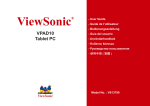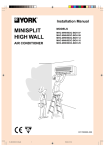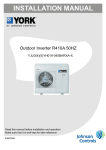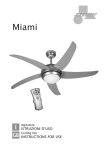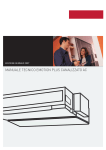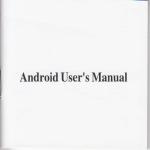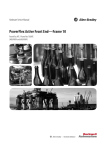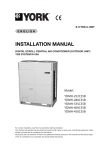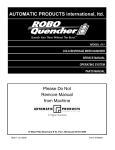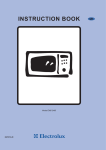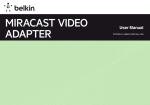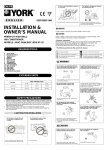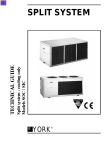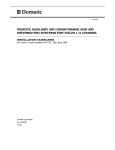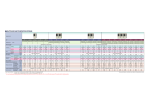Download INSTALLATION MANUAL - Saudi Arabia | Johnson Controls Inc.
Transcript
INSTALLATION MANUAL Mini-Split Air Conditioner TLCA/TLHA18-30OSAAA(D)R Read this manual before installation and operation Make sure that it is well kept for later reference Read this manual before installation and operation Make sure that it is well kept for later reference CONTENTS Safety precautions ......................................................................... 3 Part names ......................................................................................... 4 Manual operation ............................................................................ 5 How the air conditioner works .................................................. 5 Optimal operation ....................................................................... 6 Outdoor & Indoor Unit Dimension.......................................... 7 Installation procedure ................................................................. 8 Maintenance .................................................................................. 19 Operation tips .............................................................................. 20 P le a s e r e a d th is in s ta lla tio n manual carefully before starting the installation. It will tell you necessary information. Quality POLICY We will continuously strive to sat is fy our c us tome rs with c ons is te nt r e lia bility in produc t, s e rvic e a nd support through superior qual ity, service culture and distinctive technology. 2 ENGLISH Troubleshooting guide ............................................................... 21 EXTENDED PARTS REQUIRED TOOLS 1. 2. 3. 4. 5. 6. 7. 8. crew driver e agonal wrench orque wrench panner eamer ole core drill ape measure hermometer 9. Manifold guage 10. as lea detector 11. accum pump 12. Pipe clamp 13. Pipe cutter 14. lare tool set 15. lectrical circuit tester 1. efrigerant Pipe Models 18 24 30 iquid si e 1/4 inch 3/8 inch 3/8 inch as si e 1/2 inch 5/8 inch 5/8 inch 2. Pipe Insulation Material Polyethylene foam mm thic 3. inyl tape 4. Putty SAFETY PRECAUTIONS Please read this installation manual carefully before starting installation of the unit. his air conditioning system contains refrigerant under pressure, rotating parts and electrical connection which may be dangerous and can cause in ury. Installation and maintenance of this air conditioning system should only be car ried out by trained and quali ed personnel. After unpac ing, please chec the unit carefully for possible damage. efore underta ing any wor on the unit, ma e sure that the power supply has been disconnected. - WARNING & CAUTIONS INSTALLATION o not store or unpac the unit in a wet area or e pose to rain or water. It may cause the unit to short circuit and may result electric shocks or re. o not conduct installation in wet area or in the rain. It is a high risk to cause the electrical shocks. o not install in a place where ammable gas may lea . It may cause re. his system is designed for domestic or residential use only. If used in certain environments, such as a manufacturing workplace, the equipment may not function ef ciently. ENGLISH 3 PART NA ES INDOOR UNIT 3 INDOOR UNIT 2 Air inlet 1 2 3 4 5 6 7 1 ront panel frame ront panel Air lter ori ontal air ow grille ertical air ow louver oom temperature sensor isplay panel A C lectrostatic - 8 Infrared signal receiver 9 emote controller 10 rain hose, refrigerant 11 12 connecting pipe onnective cable top valve iber ilter tandard DISPLAY PANEL 4 5 Air outlet 6 1 AUTO 7 8 OUTDOOR UNIT 2 10 9 Air inlet 3 4 11 5 12 Air outlet NOTE DISPLAY PANEL All the pictures in this manual are for e planation purpose only. hey may be slightly di erent from the air conditioner your purchased. he actual shape shall prevail. NOTE he display panel on the indoor unit would loo li e one of following: OPERATING TE PERATURE Mode emperature oom temperature 1 2 3 4 5 utdoor temperature auto ooling operation eating operation rying operation 30 10 /1 18 -43 -15 -43 : or the models with low temperature cooling system 21 -52 or special tropical Models / Signal receptor his indicator illuminates when the air conditioner is in A operation. DEFROST F C & his indicator illuminates when the air conditioner starts defrosting automatically or when the warm air control feature is activated in heating operation. DIGITAL DISPLAY isplays the current setting temperature when the air conditioner is in operation. OPERATION his indicator ashes after power is on and illuminates when the unit is in operation. TI ER his indicator illuminates when IM is set / . 11 - 24 43 21 52 or special tropical Models CAUTIONS 1. If air conditioner is used outside of the above conditions, certain safety protection features may come into operation cause the unit to function abnormally. 2. oom relative humidity less than 80 . If the air conditioner operates in e cess of this gure, the surface of the air conditioner may attract condensation. Please set the vertical air ow louver to its ma imum angle ertically to the oor , and set I fan mode. 3. ptimum performance will be achieved within these operating temperature. ENGLISH MANUAL OPERATION Manual operation can be used temporarily in case you can not nd the remote controller or its batteries are exhausted. 1 2 3 Manual control button Open and lift the front panel up to an angle until it remains xed with a clicking sound. Push the button until the AUTO indicator is lit, the unit will work in o forced AUTO mode. (the default setting temperature is 24 C) Close the panel rmly to its original position. CAUTIONS • Once you push the manual button, the operation mode is shifted in an order as: AUTO, COOL, OFF. • Push the manual button until the operation indicator ashes rapidly ( ve times per second), the unit now operating in forced COOL mode. This is used for testing purposes only. On forced COOL mode, the remote operation function is unavailable. • When the OPERATION indicator goes o , the air conditioner is OFF. • To restore the remote controller operation, use the remote controller directly. Manual control button HOW THE AIR CONDITIONER WORKS AUTOMATIC OPERATION operation starts operation suppression zone 1 2 1 hours Set temperature 2 hours • When you set the air conditioner in AUTO mode, it will automatically select cooling, heating (cooling/heating models only), or fan only operation depending on what temperature you have selected and the room temperature. • The air conditioner will control room temperature automatically round the temperature point set by you. • If the AUTO mode is uncomfortable, you can select desired conditions manually. ECONOMIC OPERATION ECONOMIC Operation Cooling Fan only Cooling Room temperature Fan only Cooling Time set temperature DRYING operation When you push SLEEP button during cooling, heating (cooling only type without), or AUTO operation, the air conditioner will start following operation. The fan speed will be automatically controlled. In the operation suppression zone where capacity is kept to the minimum, overcooling is prevented by raising the temperature setting by 1°C after 1 hour and by 2°C after 2 hours of operation. The room temperature is thus regulated between the operation suppression zone and the set temperature. (It depends on the outdoor temperature.) DRYING OPERATION • The dry mode will automatically select the drying operation based on the di erence between the set temperature and the actual room temperature. • The temperature is regulated while dehumidifying by repeating turning on and o of the cooling operation or fan only. The fan speed indicator will display AUTO and low speed will be used. ENGLISH 5 EN OPTIMAL OPERATION To achieve optimal performance, Please note the following: • Ad ust the air ow direction correctly so that it is not directed on people. • Ad ust the temperature to achieve the highest comfort level. o not ad ust the unit to excessive temperature levels. • Close doors and windows on COOL or EAT modes, or performance may be reduced. • Use TIMER ON button on the remote controller to select a time you want to start your air conditioner. • o not put any ob ect near air inlet or air outlet, as the ef ciency of the air conditioner may be reduce and the air conditioner may stop running. • Clean the air lter periodically, otherwise cooling or heating performance may be reduced. • o not operate unit with horizontal louver in closed position. PREPARATION E ORE INSTALLATION • efore doing any work, check the interior power supply cord and the main breaker capacity are suf cient and the installation area is suf cient and complies with the re uirements. • Check that the power supply available agrees with name plate voltage. • Electrical work, wiring and cables must be performed in compliance with national and local wiring codes and standard. • o not use the extension cables. In the case extended cables are needed, use the terminal block. SELECTION O THE LOCATION • Select a place which provides the space around the units as shown in the diagram below. INDOOR OUTDOOR M M A 12 cm 12 cm 12 cm 230 cm 230 cm 230 cm C 12 cm 12 cm 12 cm D 15 cm 15 cm 15 cm CAUTIONS • o not install in a place that cannot bear the weight of the unit. ENGLISH 30 cm 30 cm 30 cm 200 cm 200 cm 200 cm C 0 cm 0 cm 0 cm D 30 cm 30 cm 30 cm A OUTDOOR UNIT PICTURES D I Dimension D Mo el 1 2 2 1 1 1 221 1 1 221 EN O Dimension Mo e D 1 2 1 2 ENGLISH PARTS INSTALLATION Name of part Installation plate Mounting screw ST3.9x25 C Clip anchor Refrigerant Li uid side pipe as side 4 5 ty 1 8 8 o/ .35(18,000) o/ 9.52(24000 30000) o/ 12. (18,000) o/19.05(24000 30000) NOTE A A 15cm or more mo rm ore 1 2 Parts you must purchase Remote controller Remote controller holder Seal rain elbow 8 12c 12c mo 1 1 1 1 Air rm ore lter Mounting screw ST2.9x10 C C Remote controller holder The air conditioner can be connected only to a supply with system impedance no more than 0.2 ohm. In case necessary please consult your supply authority for system impedance information. Remote controller Air blowing direction 30 c C mo 0 c m or more Part No. 1 2 3 r mo e fore ins ta lla tion, ope ra te the re mote c ontrolle r to determine its location in a reception range. • eep the remote controller at least 1 m apart from the nearest T set or stereo e uipment. • o not install the remote controller in a place exposed to direct sunlight or close to a heating source, such as a stove. • Note that the positive and negative poles are right positions when loading batteries. re re r mo mo 30 c • ore 200 cm or m 0 cm or m ore C Loop the connective cable. INSTALLATION PROCEDURE INDOOR UNIT • Place the installation guide pattern on the designated installation place and mark the hole position. • rill a hole and mount installation plate. • Make mm 4 holes, in the wall at the four corners of mouting plate (bracket) then insert appropriate mounting devices. • Install the mounting plate using 4 pieces of mounting screw securely at four corners and tighten the screw completely. o not over tighten the screws and deform the back plate. MODEL 150mm or mo re to c eiling Installa tion plate 270 Indoor unit outline Left re frigera nt pipe hole 65 65 45 120mm or more to wall 70 MODEL / 16000Btu/h model) 150mm or more from the ceiling 1036 Hooked Part Note: When installing the refrigerant pipes from others side. A hole must be place to allow fall towards the outdoor unit. ENGLISH Indoor .. . .. . .. ....... . .. .. .. .. .. ......... . . ........ .. . ..... .. . . . . . .. .. .. .. 130 120mm or more from the wall 130 65 65 50 50 . .. .. . .. .. .. .. .. ......... . ........ .. . ..... .. . .. .. .. . . 315 120mm or more from the wall 138 380 22 380 After determining the pipe hole position drill the hole at a slight downward slant towards the outdoor side. Right r efrigerant pipe hole 65 70 920 ( 5 mm 120mm or more to wall Indoor Unit Outline Outdoor CAUTIONS • e careful when handling the sharp edge of the mounting plate. W • This indoor unit is ready for connection to the outdoor unit. ■ Piping CAUTIONS • Never modify the unit by removing any of the safety guards or by passing any of the safety interlock swithces. • Connect the interconnecting cable correctly and connect the connecting cable to terminal as identified with their respective marking. • Do not damage the conductor core or inner insulation of power supply cables and do not deform or crush the cables. The auxiliary piping can be connected in the diections shown the above diagram. To connect in the ", # and $ direction, pipes will need to be extended. CAUTIONS • Bend pipes carefully to avoid flattening or obstructing them if the pipes are bent incorrectly, the indoor unit may be unstable on the wall. • Carefully arrange pipes so that pipes do not stick out of the rear plate of the indoor unit. Right Right Right Left Right Rear Bottom ■ Drain hose • Drain hose is flexible and can be routed to suit various piping arrangements. The drain line must include elbow trap (U bend). Connect a plastic condensate pipe with an internal diameter of 12 mm. For right and right rear piping EN Drain hose Drain cap .OTE$ONOTPUTTHEDRAINHOSEENDINTOWATER • The drain hose can be connected to the left or the right side. Verification of condensate water drainage: Fill the drain pan with water and observe evacuation. For left and left rear piping Drain hose Drain cap %.',)3( 9 I • • • • U Thread the indoor unit piping and cable through the hole. ang the top of the unit onto the upper ridge of them in mounting plate. Make sure that the unit is correctly hung in place by sliding it to the left, then to the right. Press the bottom left and bottom right hand corners of the unit against the mounting plate until the xing prongs click into place in the retainers provided to that e ect. a rainage line Condensate drainage line Interconnection cable Note: a) Access plate for the condensate drainage pump detection (condensate pump is available as an accessory). inyl tape he c onde ns a te e a c ua tion line s hould be ta pe d to the refrigerant lines with in l tape. OUTDOOR UNIT R P • Piping must be performed by uali ed personnel according to good refrigeration systems practices. • Piping materials and insulation materials must be of refrigerant uality. • Select the pipe diameters according to the size of unit and cut the pipe to design length by using pipe cutter. • Install the are nuts and are the end of the pipes. • Check that no foreign bodies are inside the piping. • Align the central of the connecting pipes and tighten the are nut. • Fix piping with pipe clamps and check that any pipe vibrations cannot be transmitted to the building structure. NOTE • Connect the pipe correctly. • o not apply the excessive tor ue. • Use an appropriate bending tool to form curves and avoid over tightening the refrigerant tubes. • To prevent heat loss, the two lines must be insulated separately. M P L U 15 20 20 The suction line must have a 2 gradient up to the compressor on horizontal sections. Where the di erence in elevation between the indoor unit and outdoor unit is greater than 5 meter, install an oil trap every 5 meters. ENGLISH MODEL U 18 30 R 24 5 30 5 LARE To avoid alteration of unit capacities, check that piping lengths and changes in elevation are kept to a strict minimum. efore connecting the refrigerant lines, follow the procedures below (if pre charged connection lines are not supplied): Select copper pipe diameters according to the size of unit to be installed. Install the refrigeration lines, checking that no foreign bodies get inside the piping. Install the are connectors and are the ends of the pipes. Evacuate the piping. This operation, which should last at least 15 minutes if there are large piping lengths and changes in elevation, should be followed by a leak test. To this e ect, when the piping has been evacuated, close the pressure gauge tap, note the value on the gauge, then wait for 15 minutes. If the needle moves, there is a leak in the system. Make the necessary ad ustments or repairs and repeat this procedure until the needle no longer moves. Open the service valves and top up the refrigerant charge if necessary. Insualation Low pressure igh pressure Manifold Minimum thickness mm eat pump (discharge) Li uid valve Pressure tap Outdoor Unit eat pump as Line as valve Indoor Unit Li uid Line Li uid Cooling Cooling (suction) R 22 eat pump (discharge) his unit is shipped complete with a charge of refrigerant that will be sucient for an interconnectiong piping length of meters. eat pump AS Cooling (suction) Li uid EN Cooling COLD AREA RECOMMENDATION • Outdoor heat pump unit: install the unit at least 10 cm above ground level to facilitate drainage of defrost water and prevent accumulation of ice. In e ect, defrost water can cause accumulation of ice under the unit during subfreezing outdoor temperatures. • In areas with heavy snowfall it is best to install the unit on wall supports. • In some regions. It is necessary to heat the bottom of the condensate drainage pan and the condensate drainage pip ing to avoid ice formation, and resulting ice build up in the fan compartment (heater strip must be at least 25 W/m). OK ENGLISH W Prepare the power source for exclusive with the air conditioner. The supply voltage must comply with the rated voltage of the air conditioner: The plug socket shall be accessible after installation. R All the wiring must be based on the wiring nameplate which shown on the model. CAUTIONS • Perform the wiring with suf cient capacity. Installation places legally re uire a short circuit isolator to be attached to prevent electrical shock. • o not extend the power cable code by cutting. • Power voltage should in the range of 90 110 of rated voltage. • The plug of the air conditioner takes a grounding leg, so clients should use a grounding socket so that the air conditioner can be grounded ef ciently. ed technician or a serviceman. • If the power cord is damaged, replacement should be conducted by uali N NOTE Remark per EMC irective 89/33 /EEC To prevent icker impressions during the start of the compressor (technical process), following installation conditions do apply. 1. The power connection for the air conditioner has to be done at the main power distribution. The distribution has to be of an low impedance, normally the re uired impedance reaches at a 32 A fusing point. 2. No other e uipment has to be connected with this power line. 3. For detailed installation acceptance, please refer to your contract with the power supplier if restrictions do apply for products like washing machines, air conditioner or electrical ovens. 4. For power details of the air conditioner, refer to the rating plate of the product. 5. For any uestion contact your local dealer. C CAUTIONS • Never modify the unit by removing any of the safety guards or by bypassing any of the safety interlock swithces. • Connect the connecting cable correctly and connect the connecting cable to terminal as identi ed with their respective marks. • o not scratch the conductive core inner insulator of power supply cables and do not deform or smash on the surface of cables. E C All electrical wiring and connections must comply with local codes and standards. Power supply cord and interconnection cord used must not be lighter than Polychloroprene sheeted cord (245 IEC 5 or 05RN F). isconnecting device must have a contact separation of at least 3 mm. I U TLCA OSAAA D R 21 ENGLISH I U TLHA OSAAA D R 3 4 21 I U TLC H A OSAA D R EN 5 5 8 8 5 10 5 5 ENGLISH O U TLCA OSAA D R TO INDOOR NIT O TDOOR NIT 1 2N RED C O ER O D RE Y This symbol indicates the element is optional, the actual shape shall prevail C C C E R COM RESSOR YG RED FN MOTOR S ITE COM RESSOR C CITOR E F N C CITOR O U TLHA OSAAA D R TO INDOOR NIT O TDOOR NIT 1 2N E RED C This symbol indicates the element is optional, the actual shape shall prevail Y E O ER O D RE Y C C C E R COM RESSOR YG S ITE COM RESSOR C CITOR RED FN MOTOR E F N C CITOR ENGLISH O U O U TLCA TLCA OSAADR OSAAAR 3 3 3 4 ENGLISH 5 O U TLCA OSAAAR RED M1 F N2 RED RED RED E ITE C ITE C TR NS1 1 C O TDOOR NIT S COM C RED CODE NIT1 R 2 E C 2 1 S1 RT 1 T2 2 C 1 C C C COM RESSOR C 1 COM RESSOR R N C C 2 O TDOOR F N C F N2 O TDOOR F N T1 TERMIN t2 MIDD E TERMIN RT M1 CN1 RED RED ITE CT CN NIT1 CN CN U TLHA CN1 CN11 C SOC ETS 4 21 ENGLISH C CONT CTOR TR NSFORMER OSAADR 3 I E TEM ER T RE SENSOR TR NS1 RED O CONNECTORS C RRENT IND CTOR CN CITOR CITOR CT T1 C RT N ME O TDOOR CONTRO C COM 1 S1 RED CN11 IRING DI GR M O U TLHA OSAAAR 3 3 3 4 ENGLISH E W M P 12000 tu/h I S R A S 50 z 10A /15A 220 230 0 z 1 A 220 240 50 z 220 240 or / 12000 tu/h 32A/25A or / 21000 tu/h 220 230 0 z NOTE The supply voltage must be consistent with the rate voltage of the air conditioner. D A 1. Condition to start defrosting: Units will switch to defrosting mode when either of the following conditions is met. a. Unit has been running under T3 0 and T3 3 oC for 3 minutes. o C for 40 minutes Starting efrosting Mode under condition a. T3 (°C) 2 1 0 5 10 15 20 b. Unit has been running at high temperature protection mode for 90 minutes. ( igh temperature protection mode: when coil temperature of indoor unit reaches 55°C, outdoor unit will turn o external unit fan but still keep compressor running). 25 30 35 40 45 0 50 2. Condition to stop defrosting: Units will switch back to heating mode when either of the following conditions is met. a. Unit has been running at defrosting mode for 10 minutes. b. T3 20 o C Time Elapsed (min) 1 R 2 3 3 min 4 5 ENGLISH 40 min eating mode efrosting mode T3 is coil temperature of outdoor units. MAINTENANCE WARNING ousehol Drain Cleaner No It is necessary to stop the air conditioner and disconnect the power supply before cleaning. C CAUTION Thinner • Use a dry cloth to wipe the indoor unit and remote controller. • A cloth dampened with cold water may be used on the indoor unit if it is very dirty. • The front panel of the indoor unit can be removed and cleaned with water. Then wipe it with a dry cloth. • o not use a chemically treated cloth or duster to clean the unit. • o not use benzine, thinner, polishing powder, or similar solvents for cleaning. These may cause the plastic surface to crack or deform. C Filter Handle ir reshening ilter 1 A clogged air lter reduces the cooling ef ciency of this unit. Please clean the lter once every 2 weeks. 1. Lift the indoor unit panel up to an angle until it stops with a clicking sound. 2. Take hold of the handle of the air lter and lift it up slightly to take it out from the lter holder, then pull it downwards. 3. Remove the AIR FILTER from the indoor unit. • Clean the AIR FILTER once two weeks. • Clean the AIR FILTER with a vacuum cleaner or water, then dry it up in cool place. 4. Remove the air freshening lter from its support frame (The installation and removing method of the air freshening lter is di erent depending on the models, see the pictures marked 1 and 2 on the left.) • Clean the air freshening lter at least once a month, and replace it every 4 5 months. • Clean it with vacuum cleaner, then dry it in cool place. 5. Install the air freshening lter back into position. . Insert the upper portion of air lter back into the unit taking care that the left and right edges line up correctly and place lter into position. M ir reshening ilter If you plan to idle the unit for a long time, perform the following: (1) Operate the fan for about half a day to dry the inside of the unit. (2) Stop the air conditioner and disconnect power. Remove the batteries from the remote controller. (3) The outdoor unit re uires periodic maintenance and cleaning. o not attempt to do this yourself. Contact your dealer or servicer. C 2 • Check that the wiring is not broken o or disconnected. • Check that the air lter is installed. • Check if the air outlet or inlet is blocked after the air conditioner has not been used for a long time. CAUTION • o not touch the metal parts of the unit when removing the lter. In uries can occur when handling sharp metal edges. • o not use water to clean inside the air conditioner. Exposure to water can destroy the insulation, leading to possible electric shock. • When cleaning the unit, rst make sure that the power and circuit breaker are turned o . ENGLISH EN OPERATION TIPS The following events may occur during normal operation. P Compressor protection • The compressor cannot restart for 3 minutes after it stops. Anti cold air (Cooling and heating models only) • The unit is designed not to blow cold air on EAT mode, when the indoor heat exchanger is in one of the following three situations and the set temperature has not been reached. A) When heating has ust starting. ) efrosting. C) Low temperature heating. • The indoor or outdoor fan stop running when defrosting (Cooling and heating models only). efrosting (Cooling and heating models only) • Frost may be generated on the outdoor unit during heat cycle when outdoor temperature is low and humidity is high resulting in lower heating ef ciency of the air conditioner. • uring this condition air conditioner will stop heating operation and start defrosting automatically. • The time to defrost may vary from 4 to 10 minutes according to the outdoor temperature and the amount of frost buildup on the outdoor unit. A • A white mist may generate due to a large temperature di erence between air inlet and air outlet on COOL mode in an indoor environment that has a high relative humidity. • A white mist may generate due to moisture generated from defrosting process when the air conditioner restarts in EAT mode operation after defrosting. L • . ou may hear a low hissing sound when the compressor is running or has ust stopped running. This sound is the sound of the refrigerant owing or coming to a stop. ou can also hear a low s ueak sound when the compressor is running or has ust stopped running. This is • caused by heat expansion and cold contraction of the plastic parts in the unit when the temperature is changing. • A noise may be heard due to louver restoring to its original position when power is rst turned on. D This is a normal condition when the air conditioner has not been used for a long time or during rst use of the unit. A This is caused by the indoor unit giving o smells permeated from building material, from furniture, or smoke. T AN COOL HEAT When indoor temperature reaches the temperature setting on air conditioner, the compressor will stop automatically, and the air conditioner turns to FAN only mode. The compressor will start again when the indoor temperature rises on COOL mode or falls on EAT mode (For cooling and heating models only) to the set point. ripping water may generate on the surface of the indoor unit when cooling in a high relatively humidity (relative humidity higher than 80 ). Ad ust the horizontal louver to the maximum air outlet position and select I fan speed. H The air conditioner draws in heat from the outdoor unit and releases it via the indoor unit during heating operation. heat When the outdoor temperature falls, heat drawn in by the air conditioner decreases accordingly. At the same time, loading of the air conditioner increases due to larger di erence between indoor and outdoor temperature. If a comfortable temperature cannot be achieved by the air conditioner, we suggest you use a supplementary heating device. A Power failure during operation will stop the unit completely. For the unit without Auto restart feature, when the power restores, the OPERATION indicator on the indoor unit starts ashing. To restart the operation, push the ON/OFF button on the remote controller. For the unit with Auto restart feature, when the power restores, the unit restarts automatically with all the previous settings preserved by the memory function. L isconnect the unit with power and then re connect the unit with power again. Push the ON/OFF button on the remote controller to restart operation. ENGLISH TROU LESHOOTING GUIDE P P R A. The air conditioner does not run. 1. Power failure. 2. Fuse blown or circuit breaker open. 3. oltage is too low. 4. Faulty contactor or relay. 5. Electrical connections loose. . Thermostat ad ustment too low (in heating mode) or too high (in cooling mode). . Faulty capacitor. 8. Incorrect wiring, terminal loose. 9. Pressure switch tripped. 1. Wait for power resume. 2. Replace the fuse or reset the breaker. 3. Find the cause and x it. 4. Replace the faulty component. 5. Retighten the connection. . Check thermostat setting. . Find the cause then replace capacitor. 8. Check and retighten. 9. Find the cause before reset. . The outdoor fan runs but the compressor will not start. 1. Motor winding cut or grounded. 1. Check the wiring and the compressor winding resistance. 2. Find the cause then replace capacitor. 2. Faulty capacitor. 1. There is a gas leak. 2. Li uid and gas line insulated together. 3. The room was probably very hot (cool) when you started the system. 1. Remove charge, repair, evacuate and recharge. 2. Insulate them separately. 3. Wait while unit has enough time to cool the room. 1. Thermostat ad ustment too low (in heating mode) or too high (in cooling mode). 2. Faulty fan. 3. Refrigerant charge too low, leak. 4. Air or incondensables in refriger ant circuit. 1. Check thermostat setting. E. The compressor starts but shuts down uickly. 1. Too much or too little refrigerant. 2. Faulty compressor. 3. Air or incondensables in refrigerant circuit. 4. Changeover valve damaged or blocked open (heat pump unit). 1. Remove charge, evacuate and recharge. 2. etermine the cause and replace compressor. 3. Remove charge, evacuate and recharge. 4. Replace it. F. Clicking sound is heard from the air conditioner. In heating or cooling operation any plastic parts may expand or shrink due to a sudden temperature change in this event, a clicking sound may occur. In heating or cooling operation any plastic parts may expand or shrink due to a sudden temperature change in this event, a clicking sound may occur. C. There is insuf cooling. cient heating or . The compressor runs continuously. 2. Check condenser air circulation. 3. Find leak, repair and recharge. 4. Remove charge, evacuate and recharge. ENGLISH INSTALLATION REMO AL AND DISPOSAL T A R M R U 1. Isolate all sources of electrical supply to the unit including any control system supplies switched by the unit. Ensure that all points of electrical and gas isolation are secured in the OFF position. The supply cables and gas pipework may then be disconnected and removed. For points of connection refer to unit installation instructions. 2. Remove all refrigerant from each system of the unit into a suitable container using a refrigerant reclaim or recovery unit. This refrigerant may then be reused, if appropriate, or returned to the manufacturer for disposal. U N Where appropriate, drain the refrigerant oil from each system into a suitable container and dispose of according to local laws and regulations governing disposal of oily wastes. 3. Packaged unit can generally be removed in one piece after disconnection as above. Any xing down bolts should be removed and then unit lifted from position using the points provided and e uipment of ade uate lifting capacity. Reference MUST be made to the unit installation instructions for unit weight and correct methods of lifting. Note that any residual or spilt refrigerant oil should be mopped up and disposed of as described above. 4. After removal from position the unit parts may be disposed of according to local laws and regulations. 2008 Johnson Controls, Inc. www.johnsoncontrols.com Form No.035M000349-003 Johnson Controls reserve the right to change product features without prior notice.
























